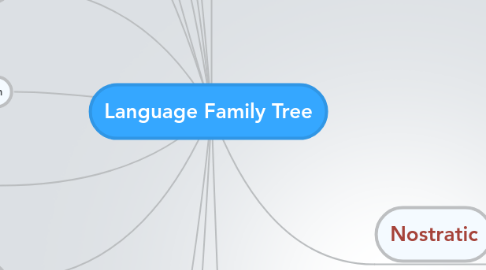
1. Austric
1.1. Austronesian
1.1.1. Tagalog
1.1.2. Filipino
1.1.3. Madurese
1.1.4. Malay
1.1.5. Bikol
1.1.6. Sunda
1.1.7. Minangkabau
1.1.8. Malagasy
1.1.9. Indonesian
1.1.10. Llocan
1.1.11. Javanese
1.1.12. Hilgaynon
1.1.13. Cebuano
1.2. Austro-Asiatic
1.2.1. Khmer
1.2.2. Santali
1.2.3. Vietnamese
2. Sino-Caucasian
2.1. Sino-Tibetan
2.1.1. Sinitic
2.1.1.1. Wu
2.1.1.2. Min
2.1.1.3. Yue
2.1.1.4. Hakka
2.1.1.5. Mandarin
2.1.1.6. Jinyu
2.1.1.7. Xiang
2.1.1.8. Gan
2.1.2. Tibeto-Burman
2.1.2.1. Burmese
3. Quechan
4. Tai-Kadai
4.1. Zhuang
4.2. Tai
5. Nilo-Saharan
6. Hmong
7. Benue-Congo
7.1. Yoruba
7.2. Shona
7.3. Nyanja
7.4. Rwanda
7.5. Gikuyu
7.6. Luba
7.7. Rundi
7.8. Kongo
7.9. Xhosa
7.10. Sesotho
7.11. Sukuma
7.12. Tswana
7.13. Zulu
7.14. Igbo
8. Niger-Congo
8.1. Mande
8.1.1. Mandingo
8.2. Gur
8.2.1. Moore
8.3. Kwa
8.3.1. Akan
8.4. Atlantic
8.4.1. Fula
9. Guarani
10. Korean
11. Hfjcjckcick
12. Two Theories of origin and diffusion of Indo-European
12.1. Nomadic Warrior Thesis
12.1.1. This theory was brought up by Marija Gimbutas. It claims that the first Proto-Indo-European speakers were the Kurgan people, whose homeland is between present day Russia and Kazakhstan. They were nomadic herders, and were among the first to domesticate horses and cattle. They migrated in search of grassland for the cattle, which took them to Siberia, and toward Iran and South Asia. Kurgan warriors used their domesticated horses as weapons, which helped them conquer much of Europe and South Asia.
12.2. Sedentary Farmer Thesis
12.2.1. The theory was brought up by Archaeologist Colin Renfrew. It claimed that the first speakers of the Proto-Indo-Europeans lived 2000 years before the Kurgans in eastern Anatolia. The Anatolians relied on trading and producing food, rather than by military conquest. When they migrated in search of food, they carried their language as well.
13. Nostratic
13.1. Dravidian
13.1.1. Tamil
13.1.2. Telugu
13.1.3. Malayalam
13.1.4. Kanada
13.2. Uralic
13.2.1. Ugric
13.2.1.1. Magyar
13.2.2. Finnic
13.2.2.1. Finnish
13.3. Altaic
13.3.1. Turkish
13.3.2. Tatar
13.3.3. Kazakh
13.3.4. Uzbek
13.3.5. Turkmen
13.3.6. Mongolian
13.3.7. Uyghur
13.3.8. Azerbaijani
13.4. Afro-Asiatic
13.4.1. Semitic
13.4.1.1. Arabic
13.4.1.2. Tigrigna
13.4.1.3. Amharic
13.4.1.4. Hebrew
13.4.2. Chadic
13.4.2.1. Hausa
13.4.3. Cushitic
13.4.3.1. Oromo
13.4.3.2. Somali
13.4.4. Berber
13.5. Indo-European
13.5.1. Balto-Slavic
13.5.1.1. East Slavic
13.5.1.1.1. Ukrainan
13.5.1.1.2. Belerusan
13.5.1.1.3. Russian
13.5.1.2. West Slavic
13.5.1.2.1. Czech
13.5.1.2.2. Slovak
13.5.1.2.3. Polish
13.5.1.3. South Slavic
13.5.1.3.1. Serbo-Crotian
13.5.1.3.2. Bulgarian
13.5.2. Indo-Iranian
13.5.2.1. Iranian
13.5.2.1.1. Balochi
13.5.2.1.2. Tajik
13.5.2.1.3. Pashto
13.5.2.1.4. Farsi
13.5.2.1.5. Kurdish
13.5.2.2. Indo-Aryan
13.5.2.2.1. Maithili
13.5.2.2.2. Nepali
13.5.2.2.3. Lahnda
13.5.2.2.4. Bhojpuri
13.5.2.2.5. Urdu
13.5.2.2.6. Konkani
13.5.2.2.7. Marathi
13.5.2.2.8. Sinhalese
13.5.2.2.9. Hindi
13.5.2.2.10. Sindhi
13.5.2.2.11. Oriya
13.5.2.2.12. Bengali
13.5.2.2.13. Gujarati
13.5.2.2.14. Assamese
13.5.2.2.15. Kasmiri
13.5.3. Romance
13.5.3.1. Sicilian
13.5.3.2. Italian
13.5.3.3. Romanian
13.5.3.4. Neapolitan
13.5.3.5. Spanish
13.5.3.6. Catlan
13.5.3.7. French
13.5.3.8. Haitian Creole
13.5.3.9. Portuguese
13.5.3.10. Lombard
13.5.3.11. Venetian
13.5.4. Germanic
13.5.4.1. North Germanic
13.5.4.1.1. Danish
13.5.4.1.2. Norwegian
13.5.4.1.3. Sweden
13.5.4.2. West Germanic
13.5.4.2.1. English
13.5.4.2.2. Gernan
13.5.4.2.3. Afrikaans
13.5.4.2.4. Dutch
